tire size DODGE DURANGO 2022 Vehicle Warranty
[x] Cancel search | Manufacturer: DODGE, Model Year: 2022, Model line: DURANGO, Model: DODGE DURANGO 2022Pages: 200, PDF Size: 6.72 MB
Page 97 of 200
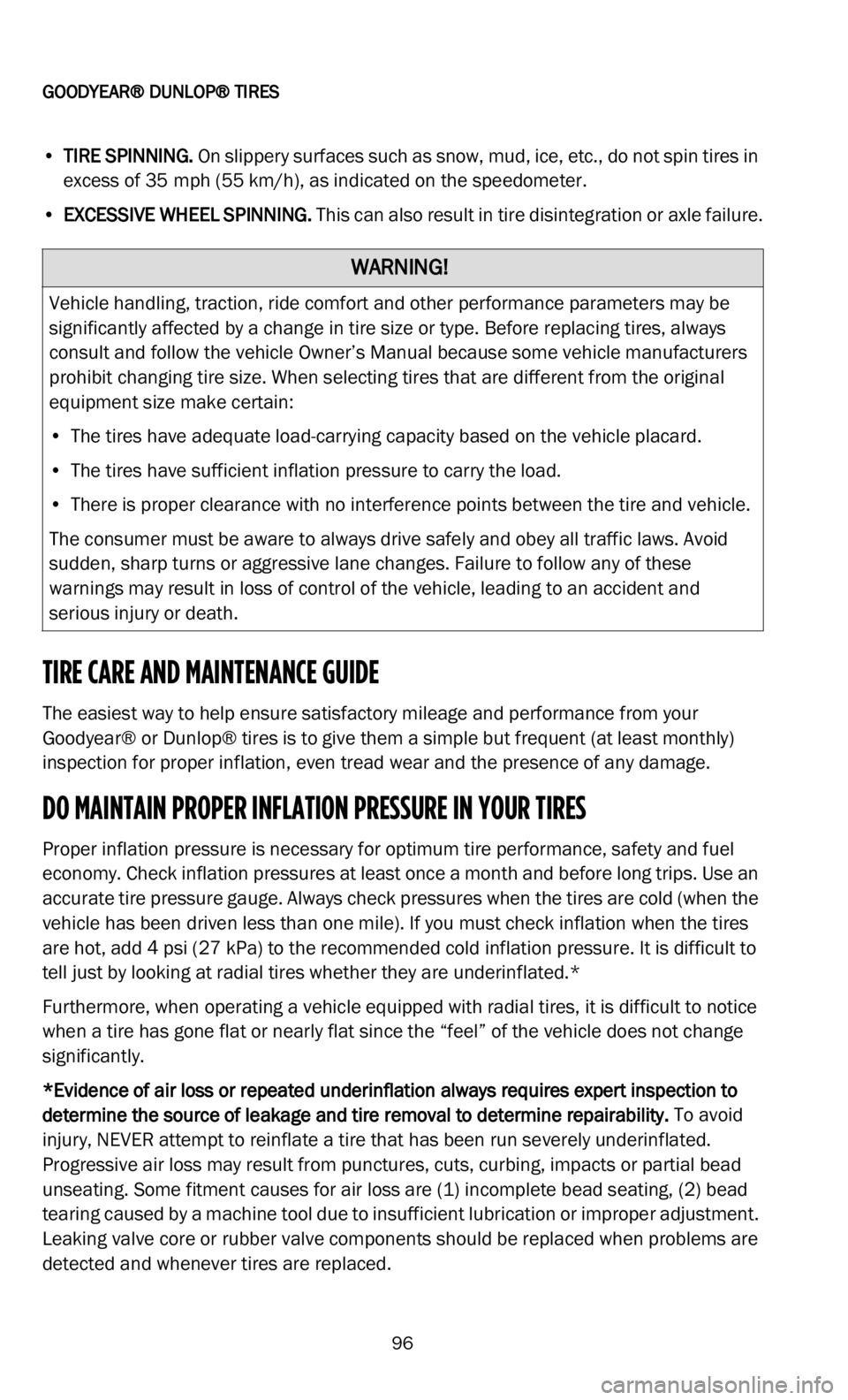
GOODYEAR® DUNLOP® TIRES
96
•TIRE SPINNING. On slippery surfaces such as snow, mud, ice, etc., do not spin tires in
excess of 35 mph (55 km/h), as indicated on the speedometer.
• EXCESSIVE WHEEL SPINNING.
This can also result in tire disintegration or axle failure.
TIRE CARE AND MAINTENANCE GUIDE
The easiest way to help ensure satisfactory mileage and performance from your
Goodyear® or Dunlop® tires is to give them a simple but frequent (at least monthly)
inspection for proper inflation, even tread wear and the presence of any damage.
DO MAINTAIN PROPER INFLATION PRESSURE IN YOUR TIRES
Proper inflation pressure is necessary for optimum tire performance, safety and fuel
economy. Check inflation pressures at least once a month and before long trips. Use an
accurate tire pressure gauge. Always check pressures when the tires are cold (when the
vehicle has been driven less than one mile). If you must check inflation when the tires
are hot, add 4 psi (27 kPa) to the recommended cold inflation pressure. It is difficult to
tell just by looking at radial tires whether they are underinflated.*
Furthermore, when operating a vehicle equipped with radial tires, it is difficult to notice
wh
en a tire has gone flat or nearly flat since the “feel” of the vehicle does not change
significantly.
*Evidence of air loss or repeated underinflation always requires expert inspection to
d e
termine the source of leakage and tire removal to determine repairability. To avoid
injury, NEVER attempt to reinflate a tire that has been run severely underinflated.
Progressive air loss may result from punctures, cuts, curbing, impacts or partial bead
unseating. Some fitment causes for air loss are (1) incomplete bead seating, (2) bead
tearing caused by a machine tool due to insufficient lubrication or improper adjustment.
Leaking valve core or rubber valve components should be replaced when problems are
detected and whenever tires are replaced.
WARNING!
Vehicle handling, traction, ride comfort and other performance parameters may be
significantly affected by a change in tire size or type. Before replacing tires, always
consult and follow the vehicle Owner’s Manual because some vehicle manufacturers
prohibit changing tire size. When selecting tires that are different from the original
equipment size make certain:
• The tires have adequate load-carrying capacity based on the vehicle placard.
•
The tires have sufficient inflation pressure to carry the load.
•
There is proper clearance with no interference points between the tire and vehicle.
T
he consumer must be aware to always drive safely and obey all traffic laws. Avoid
s u
dden, sharp turns or aggressive lane changes. Failure to follow any of these
warnings may result in loss of control of the vehicle, leading to an accident and
serious injury or death.
Page 100 of 200
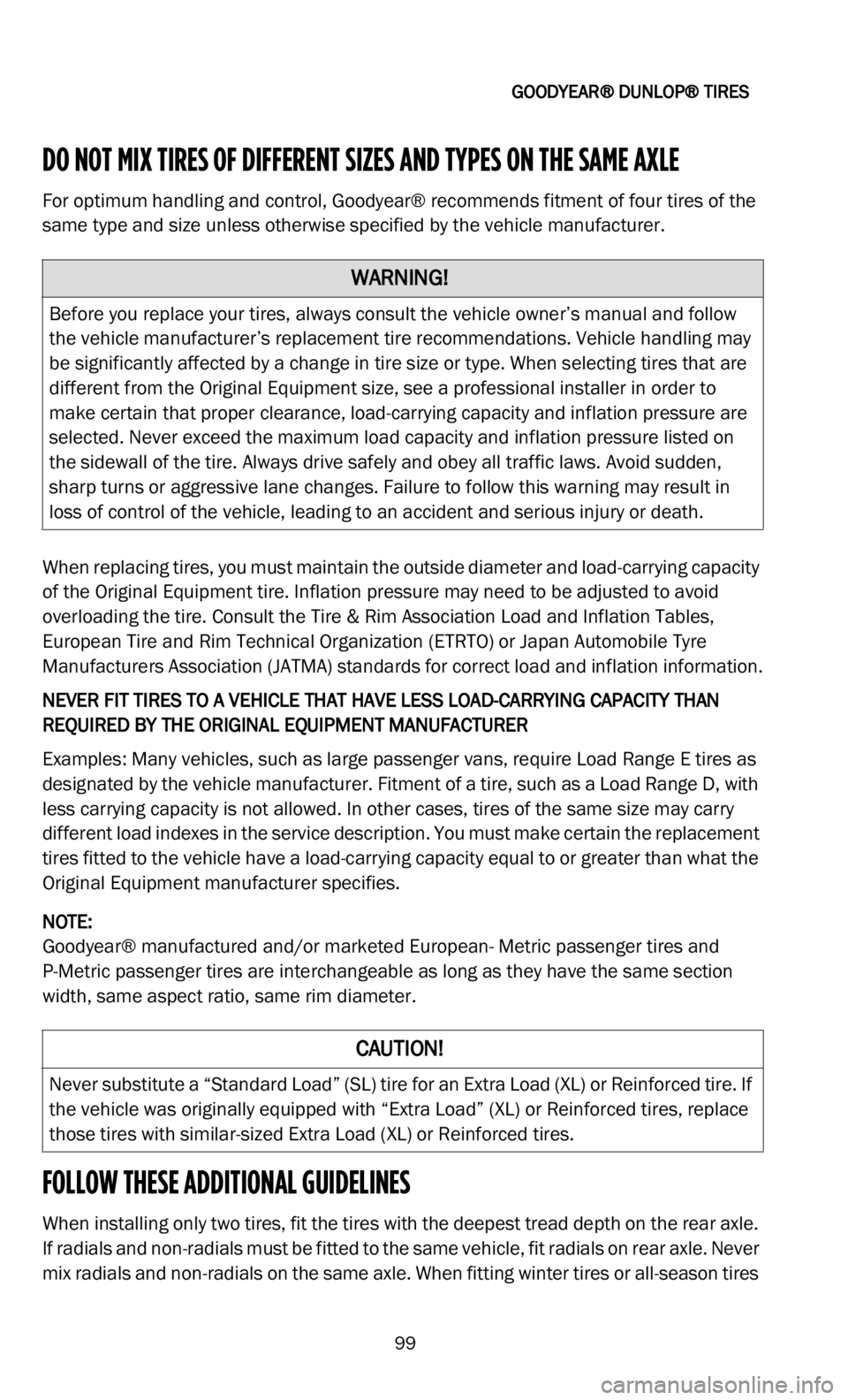
GOODYEAR® DUNLOP® TIRES
99
DO NOT MIX TIRES OF DIFFERENT SIZES AND TYPES ON THE SAME AXLE
For optimum handling and control, Goodyear® recommends fitment of four tires of the
same type and size unless otherwise specified by the vehicle manufacturer.
When replacing tires, you must maintain the outside diameter and load-carrying capacity
of
the Original Equipment tire. Inflation pressure may need to be adjusted to avoid
overloading the tire. Consult the Tire & Rim Association Load and Inflation Tables,
European Tire and Rim Technical Organization (ETRTO) or Japan Automobile Tyre
Manufacturers Association (JATMA) standards for correct load and inflation information.
NEVER FIT TIRES TO A VEHICLE THAT HAVE LESS LOAD-CARRYING CAPACITY THAN
RE
QUIRED BY THE ORIGINAL EQUIPMENT MANUFACTURER
Examples: Many vehicles, such as large passenger vans, require Load Range E tires as
d e
signated by the vehicle manufacturer. Fitment of a tire, such as a Load Range D, with
less carrying capacity is not allowed. In other cases, tires of the same size may carry
different load indexes in the service description. You must make certain the replacement
tires fitted to the vehicle have a load-carrying capacity equal to or greater than what the
Original Equipment manufacturer specifies.
NOTE:
Goodyear® manufactured and/or marketed European- Metric passenger tires and
P -
Metric passenger tires are interchangeable as long as they have the same section
width, same aspect ratio, same rim diameter.
FOLLOW THESE ADDITIONAL GUIDELINES
When installing only two tires, fit the tires with the deepest tread depth on the rear axle.
If radials and non-radials must be fitted to the same vehicle, fit radials on rear axle. Never
mix radials and non-radials on the same axle. When fitting winter tires or all-season tires
WARNING!
Before you replace your tires, always consult the vehicle owner’s manual and follow
the vehicle manufacturer’s replacement tire recommendations. Vehicle handling may
be significantly affected by a change in tire size or type. When selecting tires that are
different from the Original Equipment size, see a professional installer in order to
make certain that proper clearance, load-carrying capacity and inflation pressure are
selected. Never exceed the maximum load capacity and inflation pressure listed on
the sidewall of the tire. Always drive safely and obey all traffic laws. Avoid sudden,
sharp turns or aggressive lane changes. Failure to follow this warning may result in
loss of control of the vehicle, leading to an accident and serious injury or death.
CAUTION!
Never substitute a “Standard Load” (SL) tire for an Extra Load (XL) or Reinforced tire. If
the vehicle was originally equipped with “Extra Load” (XL) or Reinforced tires, replace
those tires with similar-sized Extra Load (XL) or Reinforced tires.
Page 101 of 200
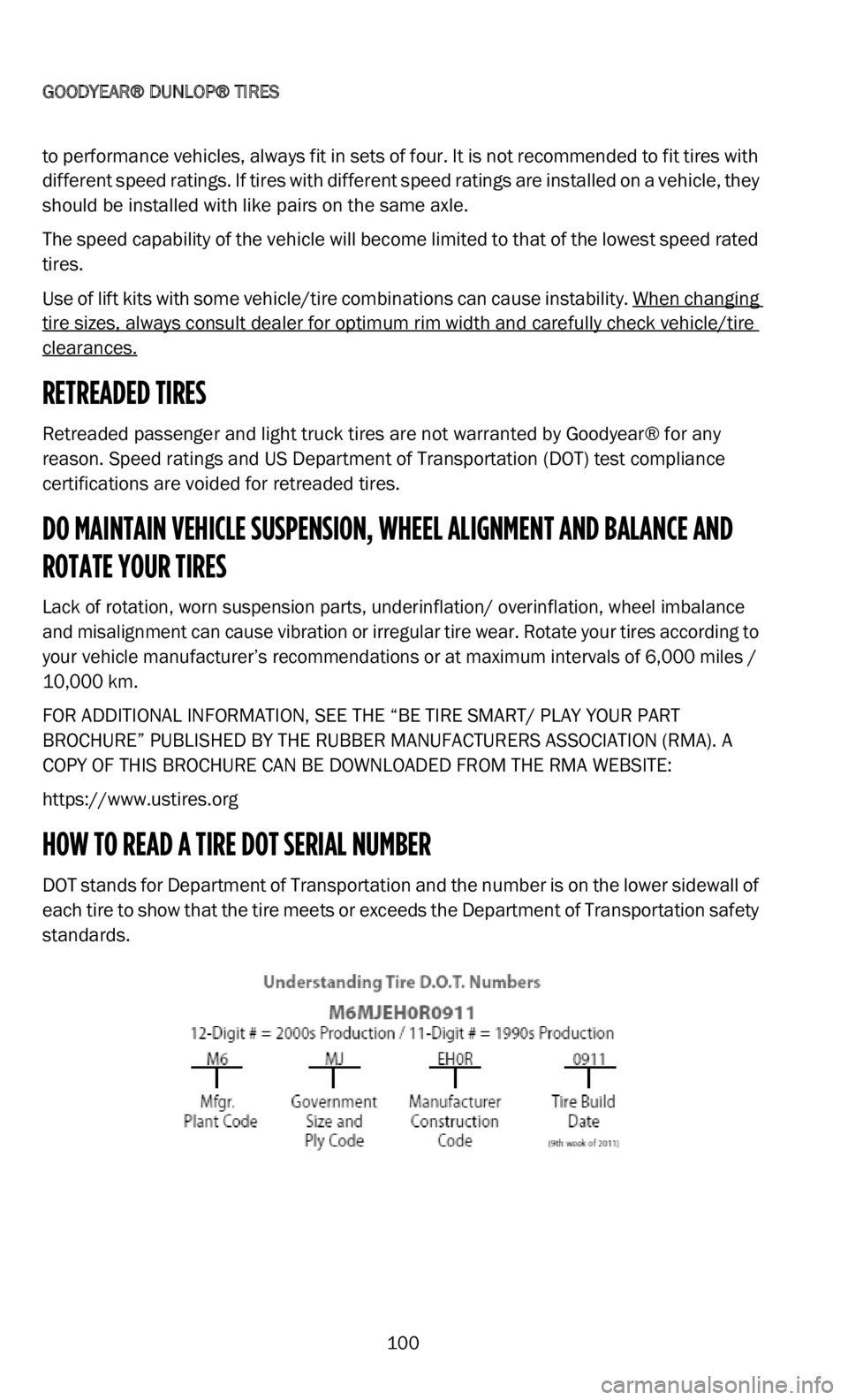
GOODYEAR® DUNLOP® TIRES
100
to performance vehicles, always fit in sets of four. It is not recommended to fit tires with
different speed ratings. If tires with different speed ratings are installed on a vehicle, they
should be installed with like pairs on the same axle.
The speed capability of the vehicle will become limited to that of the lowest speed rated
ti
res.
Use of lift kits with some vehicle/tire combinations can cause instability. When changing
tire sizes, always consult dealer for optimum rim width and carefully check vehicle/tire
clearances.
RETREADED TIRES
Retreaded passenger and light truck tires are not warranted by Goodyear® for any
reason. Speed ratings and US Department of Transportation (DOT) test compliance
certifications are voided for retreaded tires.
DO MAINTAIN VEHICLE SUSPENSION, WHEEL ALIGNMENT AND BALANCE AND
ROTATE YOUR TIRES
Lack of rotation, worn suspension parts, underinflation/ overinflation, wheel imbalance
and misalignment can cause vibration or irregular tire wear. Rotate your tires according to
your vehicle manufacturer’s recommendations or at maximum intervals of 6,000
miles /
1 0
,000 km.
FOR ADDITIONAL INFORMATION, SEE THE “BE TIRE SMART/ PLAY YOUR PART
B R
OCHURE” PUBLISHED BY THE RUBBER MANUFACTURERS ASSOCIATION (RMA). A
COPY OF THIS BROCHURE CAN BE DOWNLOADED FROM THE RMA WEBSITE:
https://www.ustires.org
HOW TO READ A TIRE DOT SERIAL NUMBER
DOT stands for Department of Transportation and the number is on the lower sidewall of
each tire to show that the tire meets or exceeds the Department of Transportation safety
standards.
Page 107 of 200

HANKOOK TIRES
106
WARNING FOR YOUR SAFETY
•TIRE DEMOUNTING AND MOUNTING
Improper tire mounting and inflation procedures may cause tire beads to break
with explosive force during installation of the tire on the rim, causing personal
injury and property damage. Follow the US Tire Manufacturers Association
(USTMA) installation and safety procedure for mounting and inflating tires. Tire
and rim must match in size. Rim parts must match by manufacturer’s design.
Clean rim. Lubricate rim and beads. Do not exceed the maximum recommended
pressure to seat beads on rim. Use remote control inflation equipment and infla -
tion cage.
NOTE:
• N ever inflate over 40 psi to seat beads.
•
Mount radial ply tires only on rims designated by wheel manufacturer as suitable
f
or radial tire.
• O nly specially trained persons shall mount tires.
• AIR PRESSURE
Check the pressure in your tires, including your spare, at least monthly, and
always before and during extended driving. Check tires cold (at least three hours
after the vehicle has been stopped and before it is driven more than 1 mile or
1.6 kilometers). Do not reduce pressure when tires are hot, use an accurate air
p r
essure gauge to check pressure and maintain it at the level recommended on
the vehicle tire placard or in the Owner’s Manual. Underinflation produces
extreme flexing of sidewalls and builds up heat to the point that premature tire
failure may occur. Overinflation can cause the tires to be more susceptible to
impact damage. Cold tire pressures, however, should never be higher than the
limit molded on the sidewall.
• LOAD LIMITS
Never exceed the load-carrying limits molded onto the sidewall of your tires or the
maximum vehicle load limit as shown on the vehicle tire placard, whichever is
less. Overloading builds up excessive heat in the tire and leads to early and/or
sudden failure.
•HAZARDS
Avoid running over objects (e.g., chuckholes, rocks, curbs, metal, glass, etc.)
which may possibly cause internal tire damage. Continued use of a tire that has
suffered internal damage (which may not be externally visible) can lead to
dangerous tire failure. Determination of suspected internal damage requires
demounting the tire from its rim and examination by trained tire personnel.
•WORN TIRES
Never drive on worn tires. Tires should be replaced by trained personnel when
2/32 of an inch (1.6 mm) of tread depth remain, as indicated by treadwear indi -
cators molded into the tread grooves. Use of worn-out tires (less than 2/32 of an
i n
ch remaining tread depth) increases the probability of tire failure. In most
states, it is illegal to drive with less than 2/32 of an inch of remaining tread depth.
Page 108 of 200

HANKOOK TIRES
107
• SPEED LIMITS
Operating your vehicle in excess of lawful speed limits or the maximum speeds
justified by driving conditions can be dangerous. Excessive speed creates heat
buildup in a tire, leading to possible tire failure.
•SPEED-RATED TIRES
Speed-rated tires are identified by letters S, T, H, V, W, or Z as either part of the
size designation (e.g., HR), or part of the service description adjacent to the size
designation (e.g., 94H) and indicates the maximum speed capability of the tire
when properly loaded and inflated. However, even when properly loaded and
inflated, driving for prolonged periods at high speeds can cause tire damage and
possible tire failure which could lead to an accident. Original equipment
speed-rated tires must be replaced with tires of the same or higher speed rating
if the speed capability of the vehicle is to be maintained. Consult your Hankook
dealer for the tires best suited to your vehicle driving habit. Repairing of
speed-rated tires must be done in accordance with USTMA repair procedures and
is limited to one 1/4 of an inch diameter repair in the tread area.
•TIRE ROTATION
Rotate your tires for longer tire life. Front and rear tires perform different jobs and
can wear differently. Consult your vehicle Owner’s Manual for mileage recom -
mendations and rotation patterns.
• ADDITIONAL SAFETY INFORMATION FOR TEMPORARY TIRE
• A ir pressure.
Check inflation pressure as soon as practical after installation and inflate to
60 psi. The tire pressure should be checked monthly and maintained at 60 psi
w h
ile the tire is stored or in service.
• Vehicle restriction.
The temporary spare tire was specifically designed for your car and should not
be used on any other vehicle.
• Other restrictions.
The temporary spare tire should not be used with other wheels, nor should
standard tires, snow tires, wheel covers, or trim rings be used with the tempo -
rary spare wheel. If such use is attempted, damage to these items or other
v e
hicle components may occur.
Page 112 of 200

KUMHO TIRES
111
4. The cost of applicable taxes and mounting and balancing and any other service charges.
5. T ire damage or irregular wear due to:
•
Road hazard, including puncture, cut, impact break, bulge, snag, stone drill, colli -
s
ion.
• C ontinued use while run flat or under acute underinflation.
•
Improper use or operation, without limitation, improper inflation pressure, over -
l
oading, use of an improper rim, tire/wheel assembly imbalance or other vehicle
c o
ndition, worn suspension components, improper mounting or de-mounting,
misuse, misapplication, fire or other externally generated heat, water or other
material trapped inside the tire during mounting, tire alteration, racing or compe -
tition purposes, improper inserting of sealant, balance or filler materials.
• Improper repair, or with repairs not conforming to the Rubber Manufacturers Asso -
c
iation standards, or with section repairs, or with self-vulcanizing plug only.
• F ailure to rotate the tire at least every 5,000 m
iles (8,047 km) as evidenced by
Ku
mho’s Mileage Warranty/Tire Rotation Card (printed in this brochure) or vehicle
misalignment.
• U neven or rapid wear which is caused by mechanical irregularity in the vehicle
s
uch as misalignment, (a measured tread difference of 2/32 of an inch or more
across the tread on the same tire).
6. O zone or weather cracking on tires over four (4) years from the date of manufacture.
7
. T ires that have been recapped, or retreaded, regrooved.
8
. R ide disturbance (out-of-round, vibration, pulling, etc.) claims submitted after the first
2
/32 of an inch of tread wear.
9. Lo ss of time, or use, inconvenience, or any incidental or consequential damage.
1
0.T ires that have been modified by the addition or removal of material or any tire inten -
t
ionally altered to change its appearance.
11.T ires unserviceability caused by the tire operation in excess of tire/wheel manufac -
t
urers specifications and recommendations.
12.T ires that are misapplied due to insufficient speed rating, or undersized, or oversized
t
ires.
13.T ires that have become unserviceable because chemical corrosion, vandalism,
c
hains and flat spotting.
14.T ires involved in any racing-related activities.
1
5.T his limited warranty applies only to the original purchaser and is nontransferable.
Page 115 of 200
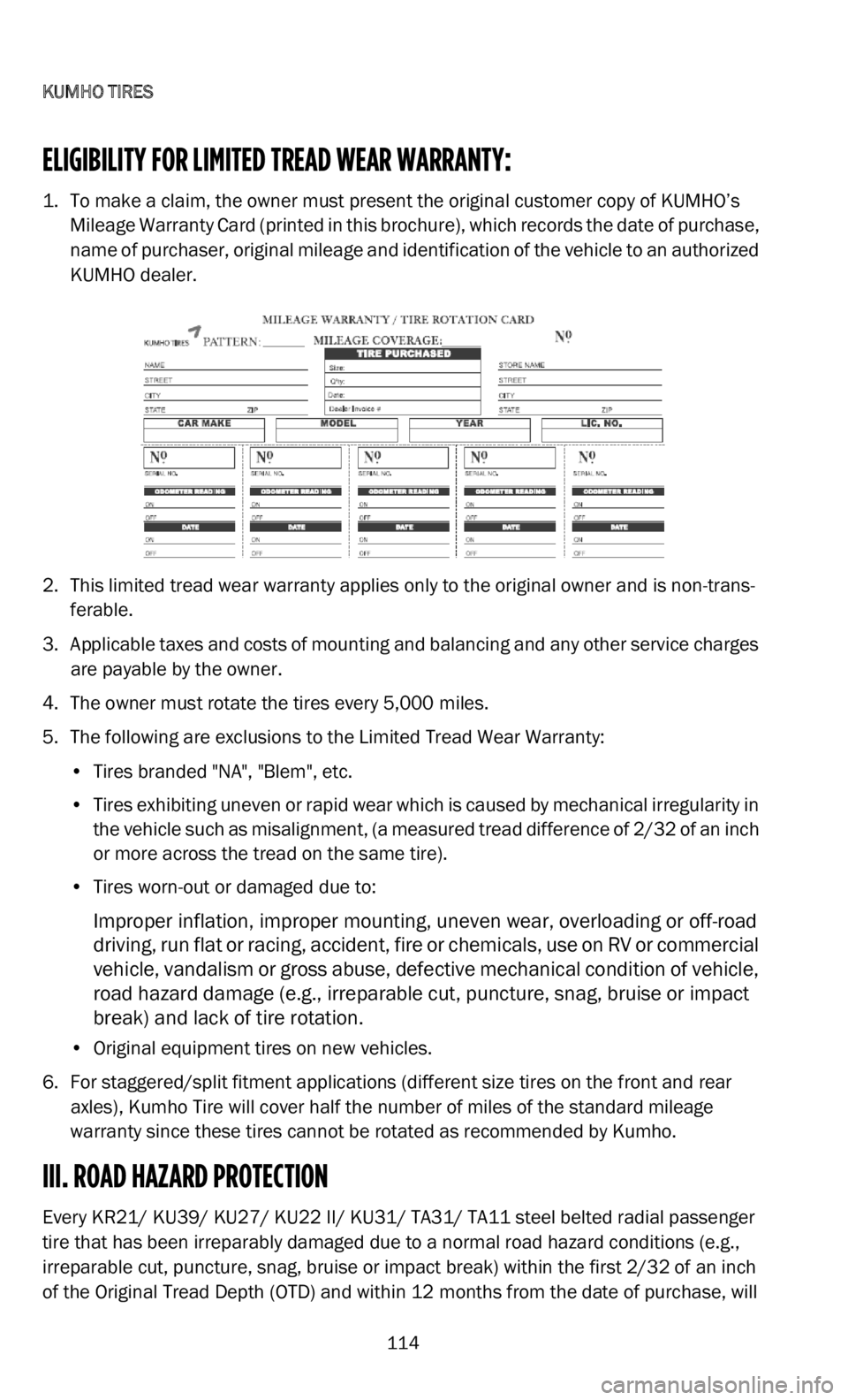
KUMHO TIRES
114
ELIGIBILITY FOR LIMITED TREAD WEAR WARRANTY:
1. To make a claim, the owner must present the original customer copy of KUMHO’s Mileage Warranty Card (printed in this brochure), which records the date of purchase,
name of purchaser, original mileage and identification of the vehicle to an authorized
KUMHO dealer.
2. T his limited tread wear warranty applies only to the original owner and is non-trans -
f
erable.
3. A pplicable taxes and costs of mounting and balancing and any other service charges
a
re payable by the owner.
4. T he owner must rotate the tires every 5,000
miles.
5. T he following are exclusions to the Limited Tread Wear Warranty:
•
Tires branded "NA", "Blem", etc.
•
Tires exhibiting uneven or rapid wear which is caused by mechanical irregularity in
t
he vehicle such as misalignment, (a measured tread difference of 2/32 of an inch
or more across the tread on the same tire).
• T ires worn-out or damaged due to:
Improper inflation, improper mounting, uneven wear, overloading or off-road
driving, run flat or racing, accident, fire or chemicals, use on RV or commercial
vehicle, vandalism or gross abuse, defective mechanical condition of vehicle,
road hazard damage (e.g., irreparable cut, puncture, snag, bruise or impact
break) and lack of tire rotation.
• Original equipment tires on new vehicles.
6. F or staggered/split fitment applications (different size tires on the front and rear
a
xles), Kumho Tire will cover half the number of miles of the standard mileage
warranty since these tires cannot be rotated as recommended by Kumho.
III. ROAD HAZARD PROTECTION
Every KR21/ KU39/ KU27/ KU22 II/ KU31/ TA31/ TA11 steel belted radial passenger
tire that has been irreparably damaged due to a normal road hazard conditions (e.g.,
irreparable cut, puncture, snag, bruise or impact break) within the first 2/32 of an inch
of the Original Tread Depth (OTD) and within 12 months from the date of purchase, will
Page 117 of 200

KUMHO TIRES
116
4. Radial truck tires used in mining service are not eligible under this program.
VI. REPLACEMENT WARRANTY
If you receive a replacement tire under this warranty, it will be covered by the
manufacturer’s warranty and the supplemental limited mileage warranty that Kumho
Tire USA, Inc. gives on that tire.
THIS IS THE ONLY EXPRESS WARRANTY GIVEN BY KUMHO APPLICABLE TO KUMHO/
MA
RSHAL REPLACEMENT TIRES. KUMHO DOES NOT MAKE ANY OTHER EXPRESS
WARRANTY OR IMPLIED WARRANTY OF MERCHANT ABILITY OR FITNESS FOR A
PARTICULAR PURPOSE.
KUMHO DOES NOT AUTHORIZE ANY OTHER PERSONS, INCLUDING AUTHORIZED
D E
ALERS TO CHANGE THIS WARRANTY OR CREATE ANY OTHER OBLIGATION IN
CONNECTION WITH KUMHO/MARSHAL TIRES. KUMHO WILL NOT DO ANYTHING OTHER
THAN WHAT IS STATED IN THIS WARRANTY IF A DEFECT IS FOUND TO EXIST IN A KUMHO/
MARSHAL REPLACEMENT RADIAL TIRE. ALL OTHER REMEDIES ARE EXCLUDED,
INCLUDING ANY OBLIGATION OR LIABILITY ON THE PART OF KUMHO FOR
CONSEQUENTIAL OR INCIDENTAL DAMAGES (SUCH AS LOSS OF USE OF CAR, LOSS OF
TIME OR INCONVENIENCE) ARISING OUT OF A DEFECT.
THE REMEDIES SET FORTH IN THIS LIMITED WARRANTY ARE THE SOLE AND EXCLUSIVE
R E
MEDIES FOR BREACH OF WARRANTY. SOME STATES DO NOT ALLOW THE EXCLUSION
OR LIMITATION OF INCIDENTAL OR CONSEQUENTIAL DAMAGES, SO THE ABOVE Tire Size
Casing Value
8.25R15, 7.50R16, 8R17.5 $30.00
215/75R17.5, 235/75R17.5 $30.00
225/70R19.5, 245/70R19.5 $30.00
265/70R19.5, 285/70R19.5 $30.00
8.25R16 $35.00
255/70R22.5 $50.00
9.00R20, 10R22.5 $60.00
10.00R20, 295/80R22.5 $80.00
11.00R20, 12.00R20 $90.00
10.00R22, 11.00R22, 12.00R24 $90.00
11R22.5, 295/75R22.5 $95.00
11R24.5, 285/75R24.5 $95.00
12R22.5, 315/80R22.5 $100.00
385/65R22.5, 425/65R22.5, 44
5/65R22.5 $100.00
Page 118 of 200
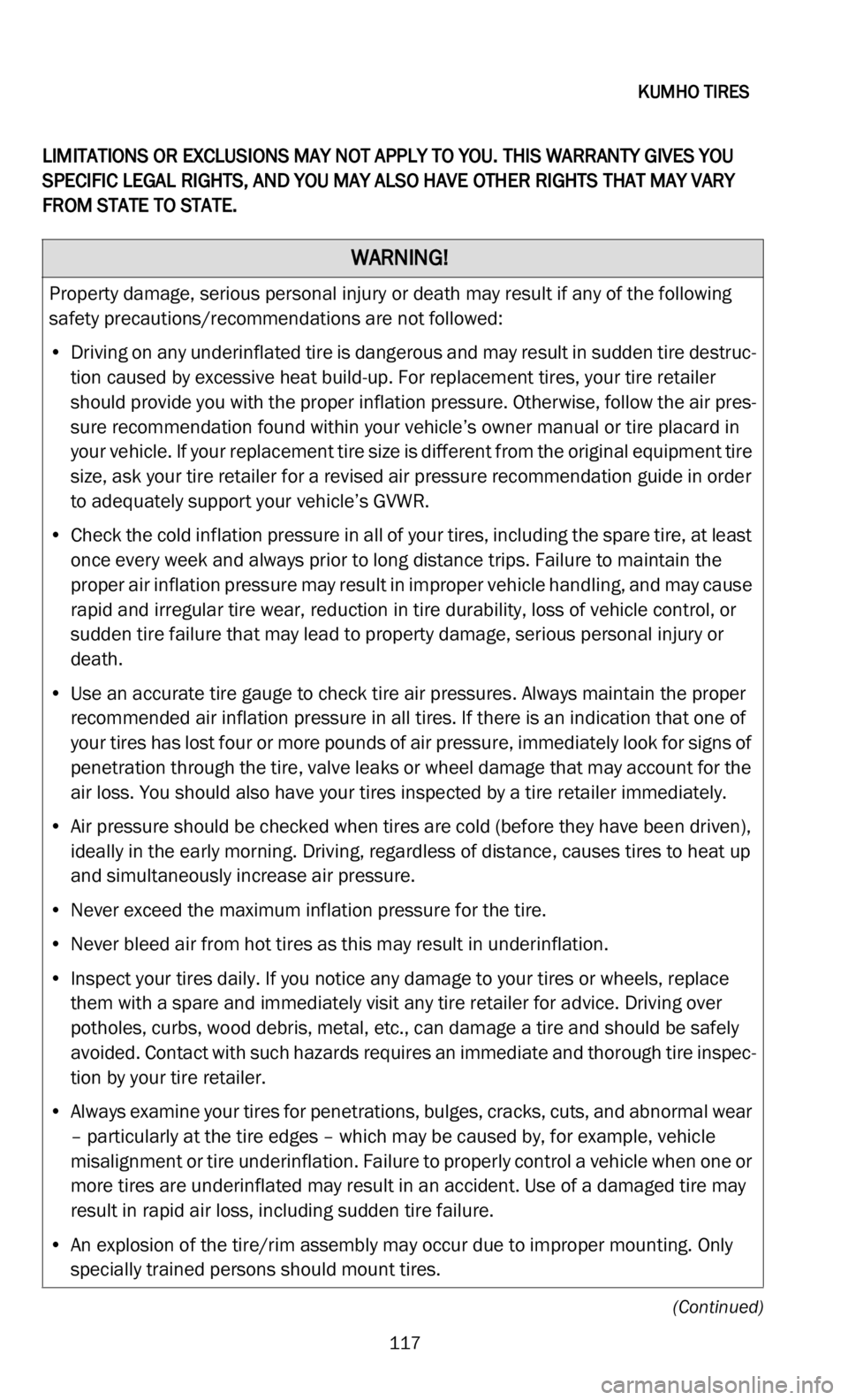
KUMHO TIRES
117
(Continued)
LIMITATIONS OR EXCLUSIONS MAY NOT APPLY TO YOU. THIS WARRANTY GIVES YOU
SPECIFIC LEGAL RIGHTS, AND YOU MAY ALSO HAVE OTHER RIGHTS THAT MAY VARY
FROM STATE TO STATE.
WARNING!
Property damage, serious personal injury or death may result if any of the following
safety precautions/recommendations are not followed:
• D riving on any underinflated tire is dangerous and may result in sudden tire destruc -
t
ion caused by excessive heat build-up. For replacement tires, your tire retailer
s h
ould provide you with the proper inflation pressure. Otherwise, follow the air pres -
sure recommendation found within your vehicle’s owner manual or tire placard in
y o
ur vehicle. If your replacement tire size is different from the original equipment tire
size, ask your tire retailer for a revised air pressure recommendation guide in order
to adequately support your vehicle’s GVWR.
• C heck the cold inflation pressure in all of your tires, including the spare tire, at least
o
nce every week and always prior to long distance trips. Failure to maintain the
proper air inflation pressure may result in improper vehicle handling, and may cause
rapid and irregular tire wear, reduction in tire durability, loss of vehicle control, or
sudden tire failure that may lead to property damage, serious personal injury or
death.
• U se an accurate tire gauge to check tire air pressures. Always maintain the proper
r
ecommended air inflation pressure in all tires. If there is an indication that one of
your tires has lost four or more pounds of air pressure, immediately look for signs of
penetration through the tire, valve leaks or wheel damage that may account for the
air loss. You should also have your tires inspected by a tire retailer immediately.
• Air pressure should be checked when tires are cold (before they have been driven), i
deally in the early morning. Driving, regardless of distance, causes tires to heat up
and simultaneously increase air pressure.
• N ever exceed the maximum inflation pressure for the tire.
•
Never bleed air from hot tires as this may result in underinflation.
•
Inspect your tires daily. If you notice any damage to your tires or wheels, replace
t
hem with a spare and immediately visit any tire retailer for advice. Driving over
potholes, curbs, wood debris, metal, etc., can damage a tire and should be safely
avoided. Contact with such hazards requires an immediate and thorough tire inspec -
tion by your tire retailer.
• Always examine your tires for penetrations, bulges, cracks, cuts, and abnormal wear –
particularly at the tire edges – which may be caused by, for example, vehicle
misalignment or tire underinflation. Failure to properly control a vehicle when one or
more tires are underinflated may result in an accident. Use of a damaged tire may
result in rapid air loss, including sudden tire failure.
• An explosion of the tire/rim assembly may occur due to improper mounting. Only s
pecially trained persons should mount tires.
Page 121 of 200

MICHELIN®
120
lost all air! That means time to get off the highway and get to a place where the tire can
be inspected, replaced, or possibly repaired and returned to service. That is peace of
mind!
MICHELIN® PASSENGER AND LIGHT TRUCK TIRE LIMITED WARRANTY
WHAT IS COVERED AND FOR HOW LONG
Passenger and Light Truck Tires Michelin® Passenger and Light Truck tires, used in
no
rmal service on the vehicle on which they were originally fitted and in accordance with
the maintenance recommendations and safety warnings contained in the attached
owner’s manual, are covered by this warranty against defects in workmanship and
materials for the life of the original usable tread, or six years from the date of purchase,
whichever occurs first. At that time, all warranties, express or implied, expire. The usable
tread is the original tread down to the level of the tread wear indicators - 2/32 of an inch
(1.6 mm) of tread remaining. Date of purchase is documented by new vehicle
re
gistration or tire sales invoice. If no proof of purchase is available, coverage will be
based on the date of manufacture.
Replacement will be made in accordance with the terms and conditions described under
“ H
ow Replacement Charges are Calculated”.
NOTE:
Your vehicle manufacturer may provide additional tire warranty coverage over and above
w h
at is provided by Michelin®. Consult your vehicle Owner’s Manual for further informa -
tion.
NOTE:
Some Michelin® Self-Supporting Zero Pressure (ZP) tires can only be mounted on special
S H
-M (Symmetric Hump - Modified) wheels. These tires bear the special SH-M designa -
tion, molded into the sidewall of the tire, next to the ZP designation. DO NOT MOUNT A
T I
RE WITH THE SH-M DESIGNATION ON THE SIDEWALL ON A STANDARD WHEEL. DOING
SO VOIDS THIS LIMITED WARRANTY AND COULD CAUSE THE TIRE TO BECOME UNSER -
VICEABLE AT LOW OR ZERO PRESSURE, RESULTING IN SERIOUS PERSONAL INJURY OR
D E
ATH.
Treadwear – Mileage Warranty Coverage for Michelin® Passenger and Light Truck Tires
Michelin® passenger and light truck tires are covered by a manufacturer’s limited
w a
rranty for treadwear. For the mileage warranty associated with a specific tire line,
please see your Michelin® tire retailer or visit us at https://www.michelinman.com/
home . Some vehicles come from the vehicle manufacturer with “split fitments” –
meaning different size tires on the front and rear axles. Because these tires cannot be
r o
tated as recommended by Michelin®, the mileage warranty on each rear tire will cover
half the number of miles as the standard mileage warranty for that particular tire design.
Michelin® Self-Supporting Zero Pressure (ZP) tires have the same mileage warranty as
the standard tire line of which they are a part, up to but not exceeding 30,000 miles.
D O
T-approved competition tires (e.g., Michelin® Pilot® Sport Cup tires) are excluded
from any mileage warranty. Michelin® Winter tires must be used during winter months
only, defined as a period beginning on or after September 1st of a given year and ending